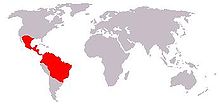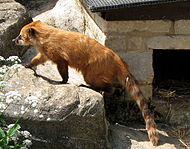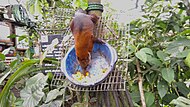Coati
This article needs additional citations for verification. (May 2020) |
| Coati | |
|---|---|

| |
| White-nosed coati (Nasua narica) | |
| Scientific classification | |
| Domain: | Eukaryota |
| Kingdom: | Animalia |
| Phylum: | Chordata |
| Class: | Mammalia |
| Order: | Carnivora |
| Family: | Procyonidae |
| Subfamily: | Procyoninae
|
| Tribe: | Procyonini
|
| Subtribe: | Nasuina |
| Genera | |

| |
| Range map | |
Coatis (from
Physical characteristics
Adult coatis measure 33 to 69 cm (13 to 27 in) from head to the base of the tail, which can be as long as their bodies. Coatis are about 30 cm (12 in) tall at the shoulder and weigh between 2 and 8 kg (4.4 and 17.6 lb), about the size of a large house cat. Males can become almost twice as large as females and have large, sharp canine teeth. The measurements above relate to the white-nosed and South America coatis. The two species of mountain coati are smaller.[7]
All coatis share a slender head with an elongated, flexible, slightly upturned nose, small ears, dark feet, and a long non-prehensile tail used for balance and signaling.
Ring-tailed coatis have either a light brown or black coat, with a lighter underpart and a white-ringed tail in most cases. Coatis have a long brown tail with rings on it which are anywhere from starkly defined like a
Coatis have
The coati snout is long and somewhat pig-like – part of the reason for its nickname 'the hog-nosed raccoon'. It is also extremely flexible and can rotate up to 60° in any direction. They use their noses to push objects and rub parts of their body. The facial markings include white markings around the eyes and on the ears and snout.
Coatis have strong limbs to climb and dig and have a reputation for intelligence, like their fellow procyonid, the raccoon. Unlike nocturnal raccoons, however, most coatis are diurnal, although some may exhibit cathemeral behavior.[8] They prefer to sleep or rest in elevated places and niches, like the rainforest canopy, in crudely built sleeping nests.
Habitat and range
Overall, coatis are widespread, occupying habitats ranging from hot and
Taxonomy
|
The following species are recognised:[7][11][12]
- Genus Nasua
- Nasua narica (Linnaeus, 1766) – white-nosed coati (Southwestern United States, Mexico, Central America, and Colombia)
- Nasua nasua (Linnaeus, 1766) – South American coati (South America)
- Genus Nasuella
- Nasuella meridensis (Thomas, 1901) – eastern mountain coati (Venezuela)
- Nasuella olivacea (Gray, 1865) – western mountain coati (Colombia and Ecuador)
The
Lifespan
Coatis can live up to seven years in the wild. In captivity, their average lifespan is about 14 years, and some coatis can live into their late teens.[19]
Feeding habits
Coatis are
Behaviour

Little is known about the behaviour of the mountain coatis,
When provoked, or for defence, coatis can be fierce fighters; their strong jaws, sharp canine teeth, and fast scratching paws, along with a tough hide sturdily attached to the underlying muscles, make it very difficult for potential predators (e.g., dogs or jaguars) to seize the smaller mammal.
Coatis communicate their intentions or moods with chirping, snorting, or grunting sounds. Different chirping sounds are used to express joy during social grooming, appeasement after fights, or to convey irritation or anger. Snorting while digging, along with an erect tail, states territorial or food claims during foraging. Coatis additionally use special postures or moves to convey simple messages; for example, hiding the nose between the front paws as a sign for submission; lowering the head, baring teeth, and jumping at an enemy signal an aggressive disposition. Individuals recognise other coatis by their looks, voices, and smells, the individual smell is intensified by special musk-glands on their necks and bellies.
Coatis from
Reproduction
Coati breeding season mainly corresponds with the start of the rainy season to coincide with maximum availability of food, especially fruits: between January and March in some areas, and between October and February in others. Female and young coatis commonly live in bands of 5 to 40 and travel together. The males are solitary and join the bands only during the short mating season. For this period, an adult male is accepted into the band of females and juveniles near the beginning of the breeding season, leading to a polygynous mating system.
The pregnant females separate from the group, build a nest on a tree or in a rocky niche and, after a gestation period of about 11 weeks, give birth to
Natural predators
Coati predators include
Status
In Central and South America, coatis are threatened by environmental destruction and unregulated hunting. A lack of scientifically sound population studies could be leading to an underestimation of the coati population and other ecological problems affecting the species.[citation needed]
In captivity
Coatis are one of five groups of procyonids commonly kept as pets in various parts of North, Central and South America, the others being the raccoons (common and crab-eating), the kinkajou, the ring-tailed cat and cacomistle. However, while both the white-nosed and South America coatis are common in captivity, mountain coatis are extremely rare in captivity.[24][25]
Coatis are small creatures that can be wild, somewhat difficult to control or train in some cases, and generally behave in a manner radically different from that of a pet dog.[26] Optimally, they should have a spacious outdoor enclosure and a coati-proofed room in the house and/or other climate-controlled place, as well. They can be given the run of the house but need careful watching, more careful in some cases than others.
It is possible to litter or toilet train coatis;[27] if one cannot be trained as such, it is still possible to lessen problems in that they tend to designate a latrine area, which can have a litter pan placed in it as is done with many ferrets, pet skunks, rabbits, and rodents.[27] Coatis generally need both dog and cat vaccines for distemper and many other diseases and an inactivated rabies vaccine. They can be spayed or neutered for the same reason as cats and dogs and other pets.
Gallery
-
White-nosed coati at Tikal, Guatemala
-
South American coati, Nasua nasua, in an English zoo
-
White-nosed coati in Rincón de la Vieja National Park, Costa Rica
-
South American coati near Iguaçu Falls, Brazil
-
White-nosed coati on Mt. Hopkins near Madera Canyon (Arizona)
-
Coati at a zoo in the Czech Republic
-
Coati foraging in Playa del Carmen, Mexico
-
South American coati seeking discarded food in the Iguazú [Falls] National Park of Argentina
-
Pair of South American coatis atXel-ha aquatic theme park in Quintana Roo, Mexico
-
A coati feeding on fruit at a monkey sanctuary (Paseo de los Monos) in the Amazon of Puyo, Ecuador.
References
- doi:10.2307/1374677.
- ^ . Retrieved 12 November 2021.
- ^ Braddy, Sarah. Nasua nasua South American coati. Animal Diversity Web at University of Michigan. "Coatis are also referred to in some texts as coatimundis. The name coati or coatimundi is Tupian Indian in origin."
- ^ "Coatimundi". Merriam-Webster. Retrieved 6 November 2021.
History and Etymology for coatimundi Portuguese quatimundé, from Tupi kwatimúnde, older male coati not with a band, from kwáti coati + múnde snare, trap
- ^ "Coati". San Diego Zoo. Retrieved 6 November 2021.
- ^ "Coatimundi - The Belize Zoo". www.belizezoo.org. Retrieved 17 November 2022.
- ^ a b c d Helgen, K. M.; Kays, R.; Helgen, L. E.; Tsuchiya-Jerep, M. T. N.; Pinto, C. M.; Koepfli, K. P.; Eizirik, E.; Maldonado, J. E. (August 2009). "Taxonomic boundaries and geographic distributions revealed by an integrative systematic overview of the mountain coatis, Nasuella (Carnivora: Procyonidae)". Small Carnivore Conservation. 41: 65–74. Retrieved 26 October 2018.
- .
- PMID 12071327.
- ^ "Exotic animals 'found wild in UK'". BBC News. 21 June 2010.
- ^ OCLC 62265494.
- OCLC 62265494.
- ISBN 978-84-96553-49-1
- ^ Decker, D. M. (1991). "Systematics of the Coatis, Genus Nasua (Mammalia, Procyonidae)" (PDF). Proceedings of the Biological Society of Washington. 104: 370–386. Archived from the original (PDF) on 6 October 2014. Retrieved 6 May 2012.
- ISBN 0195064011
- PMID 17174109.
- PMID 20138220.
- ^ PMID 24003317.
- ^ "White-nosed coati". Smithsonian's National Zoo. 6 June 2017. Retrieved 2 January 2022.
- ISBN 978-0-9705678-1-9.
- ^ "White Nose Coati". Turpentine Creek Wildlife Refuge. Retrieved 1 October 2022.
- ^ Southern Coatimundi. itech.pjc.edu
- S2CID 146496.
- ISIS (2011). Nasua.Version 12 January 2011.
- ^ WildlifeExtra (August, 2010). First ever Mountain coati in captivity in Colombia. Archived 2016-04-02 at the Wayback Machine
- ^ Coat Mundi (kow'aatee'múndee). However if they are trained properly, they could be really docile. blackpineanimalpark.com
- ^ a b Quick Reference Guide to 21 Exotic Species. Exotic DVM, Vol. 8 #6 2006
External links
 The dictionary definition of coati at Wiktionary
The dictionary definition of coati at Wiktionary








![South American coati seeking discarded food in the Iguazú [Falls] National Park of Argentina](http://upload.wikimedia.org/wikipedia/commons/thumb/b/b4/CoatiScavengingIguaz%C3%BA.jpg/190px-CoatiScavengingIguaz%C3%BA.jpg)

